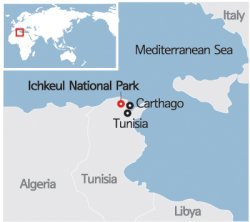공유하기
<5> Ichkeul National Park, A Haven for Migratory Birds
- 동아닷컴
-
입력 2010년 9월 15일 00시 00분
글자크기 설정
Preserving a Sanctuary for Birds Traveling Between Africa and Europe

《 I found it difficult to even swallow my saliva. All I could feel was the stillness under the scorching sunlight. Beads of sweat began to form on the tip of my nose. The four-wheel drive jeep shrank to the size of a fist behind my back and only hollow footsteps continued like a thread on top of the mud flats. Though I walked for a long time, the lake seemed like a distant mirage. How much further did I walk? A faint wave of orange light lapped in front of me. I hurriedly took out my camera. I saw the peculiarly extended neckline and legs of a flamingo through my camera lens. After hours of walking around without promise, hundreds of flamingos revealed themselves. It was the moment when I finally met the true inhabitants of Tunisia's Ichkeul National Park, the biggest habitat of migratory birds in North Africa where 300,000 birds come each year. 》
Ichkeul, Tunisia = Jung Yanghwan, Staff Writer
"A bird calls out to me. Let us meet some place in this lonely planet of ours."
From the poem Life Yet to Reach by Choi Young Mi.
"Ichkeul's lake alone measures more than 8,500 hectares. Including Ichkeul Mountain (511 meters above sea level), the total area comes to 12,600 hectares. Even wild animals hardly move around when the heat hovers around 40 degrees Celsius around noon. If you want to look around more, we must start early in the morning."
A feeling of desolation filled the park during my early departure. The green trees almost appeared black and the lake looked flat from above a hilltop. A lone gray-colored hawk could be seen gliding above the clouds looking for his morning prey. I started to wonder why the United Nations Educational, Scientific and Cultural Organization named this park a world heritage site.
"Don't be anxious about the outward appearance of Ichkeul. It will be easy to miss the park's true qualities. The summer scenery here is as tranquil as a still-life painting from a distance," said Gharouani. "If you came looking for wild animals roaming Africa's grasslands, you're at the wrong place. Even experts hardly run into Berberian wild boars, golden jackals, Egyptian mongooses or genets. Try to look at Ichkeul's unique environment."
Such ample eco-system is the driving force that supports over 250 types of migratory birds. Ichkeul provides plenty of food and shelter to the birds flying to and from Europe and Africa. During winter, widgeons, pochards and graylags fill the lake. Globally endangered animals such as white-headed ducks can be spotted as well. And the flamingo is the typical summer guest here.
"The trees remained lonely without a word for ages, and that is why they emit an eternal youthful maturity."
From the novel Life of Arseniev by Ivan Alekseyevich Bunin
To migratory birds here, Ichkeul is like life-giving water. This is the only land in North Africa that has suitable humidity for birds. Nearby sources of moisture have long been turned into farmlands. But Ichkeul has been the property of the royal family since the 13th century and from the 18th century to 1950 it was protected as the private property of the Royal House of Husain. After the establishment of the Tunisian republic, Ichkeul was designated a national park in 1980 and also as a UNESCO world heritage site the same year, escaping harm's way.
"The number of migratory birds coming to the park has shrunk visibly. At the height of the crisis, only 30 to 40-thousand birds came. As the lake's water was depleted, salt content rose causing the ecological environment to degenerate. North Africa's only habitat for migratory birds could have disappeared if not for the devotion of the government and UNESCO."
This prompted a strict management system for Ichkeul starting in the late 1990s. Frequent poaching was completely banned and the mining of limestone and marble from the mountain was suspended. Most importantly, they paid attention to the level of salt to preserve wetland vegetation. The appropriate level during the winter is 10 grams of salt per liter of water and 35 grams in the summer. They installed salt measuring instruments across the lake and inspected them frequently. The hard work paid off when Ichkeul was removed from the danger list in 2006. But Armed Benabdallah, section chief of UNESCO, Tunisian National Commission for UNESCO, doesn't put his guard down.
"Just because it was removed from the danger list, it doesn't mean that risk has gone. Just last year there was a draught so we were very cautious this year. We go on regular explorations every few months with the government. Fortunately, salt level is stable at the moment. We must spare no efforts so that Ichkeul can exist forever with mankind."
"Politics that honors human life is returning the original habitat to organisms and humans."
From the Bio-Capital by Andreas Weber
This passage resonates with the ultimate goals of Ichkeul. Unlike other environmentally protected areas, residents live inside this park. About 100 households that received permits from the government reside here. They cultivate land around the park and catch fish in the lake and nearby sea. One may worry that they could invade nature, but Director Jose thinks otherwise.
"People have lived around this area sine the Stone Age meaning that man and nature have coexisted for a long time. Rather than force them to live elsewhere, having them live within nature is the better way. UNESCO agreed to this point as well."
But whether of not this coexistence will continue to be a success remains a question mark. Outside the park, cultivated land area continues to grow along with the population. And it's not clear if farmers inside and outside the park are conserving nature. "We are active in promoting and enforcing nature conservation, but some outside farmers freely come into the park and cause damage," worried Mr. Gharouani, the park director.

-
- 좋아요
- 0개
-
- 슬퍼요
- 0개
-
- 화나요
- 0개



![[횡설수설/장원재]관광객도 SNS 5년 치 검사하겠다는 美](https://dimg.donga.com/a/464/260/95/1/wps/NEWS/FEED/Donga_Home_News2/132957828.2.thumb.jpg)


댓글 0